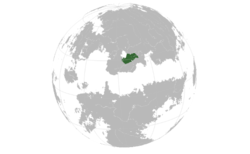Difference between revisions of "Komania"
| Line 1: | Line 1: | ||
{{Infobox country | {{Infobox country | ||
|conventional_long_name = The | |conventional_long_name = The Great State of Komania | ||
|native_name = [[Koman language|Koman]]: | |native_name = [[Koman language|Koman]]: Xālxāra Xāzēho <br>[[Mishar language|Mishar]]: Gálákál Sur-Gázuthö | ||
|common_name = Komania | |common_name = Komania | ||
|image_flag = Flag Komania.png | |image_flag = Flag Komania.png | ||
| Line 11: | Line 11: | ||
|symbol_type = Emblem | |symbol_type = Emblem | ||
|national_motto = TBA <br><small>''Long stands the Emperor!''</small> | |national_motto = TBA <br><small>''Long stands the Emperor!''</small> | ||
|national_anthem = '' | |national_anthem = ''Osān Bivē''<br><small>''Golden song''</small> | ||
|other_symbol_type = <!--Use if a further symbol exists, e.g. hymn--> | |other_symbol_type = <!--Use if a further symbol exists, e.g. hymn--> | ||
|other_symbol = | |other_symbol = | ||
Revision as of 21:46, 29 September 2017
| The Great State of Komania |
||||||
|---|---|---|---|---|---|---|
|
||||||
| Motto: TBA Long stands the Emperor! |
||||||
| Anthem: Osān Bivē Golden song |
||||||
| Capital | Jānvān | |||||
| Largest city | Sāmādar | |||||
| Official languages | Koman | |||||
| Recognised regional languages | Balaki, Mishar | |||||
| Ethnic groups | Koman (82 %) Other (11 %) |
|||||
| Religion | Thaghaism | |||||
| Demonym | Koman | |||||
| Government | Constitutional Monarchy | |||||
| - | Xāzēn (emperor) | Mişanli Āşar | ||||
| - | Prime minister | Dāmeğa Bāşak | ||||
| Legislature | State Assembly | |||||
| Establishment | ||||||
| - | Kali Tribal Confederation | c.100 | ||||
| - | Kalkali Nomadic Empire | 700-1220 | ||||
| - | Sunrise Horde | 1220-1289 | ||||
| - | Great Horde | 1289- 1657 | ||||
| - | Oshar States | 1657 - 1769 | ||||
| - | Koman Empire | 1793 | ||||
| Area | ||||||
| - | 814.130 km2 314 sq mi |
|||||
| Population | ||||||
| - | 2016 estimate | 42,904,651 | ||||
| - | Density | 52.7/km2 136.5/sq mi |
||||
| Gini | 46 high |
|||||
| HDI (2016) | 0.786 high |
|||||
| Time zone | SCT +3 | |||||
| - | Summer (DST) | not observed (SCT) | ||||
| Drives on the | right | |||||
| Internet TLD | .km | |||||
The Empire of Komania (Koman: Hālhāra Xāzēho ; IPA: [hɒlhɒ'ra xɒ:zəho'];Mishar: Gálákál Sur-Gázuthö) is a landlocked country bordered by Sotanxina by the west, Dohjan to the North and Balakia to the East, located along the Melkanchuta lake on the Vaniuan region, it is the homeland of the Koman people, a Vaniuan ethnic group. Its capital is the city of Jānvān, according to the 2016 census the total population is 42,904,651.
Etymology
The country is natively known as -Halhara-, Hālhāra; IPA: /hɒlhɒ'ra/; having the suffix -a meaning "place of" or "land of" allegedly borrowed from Old Mahavic leaving the root word as Kālyāğār, which is attested to have evolved from the tribal name Kalkali as found written in several steles throughout the Golden steppes in Vaniua. According to the Boshom inscriptions found near the village of Şüğdar in the Bāşām region, the name is of tribal origin designating the Kalkali Empire and its people, having possible roots with their forefathers the nomadic Kali who roamed the Golden steppes c.100, having derived from the name Kali probably meaning of the Kali or from the Kali having an attested Mahavic origin.
Modern Komans make use of varied alternative names to designate their land, most of them being poetic in nature, Şērhāşēm "Land of black sands" being the most common term with Kārāgārēm and Xārāğārēm as variants from different dialects.
Komans use the tribal name "Kāman" meaning "of the ten" to refer to themselves, with roots from the tribe of "Kām" from the Kalkali Nomadic Empire who migrated to their current lands as the predominant tribe before being subjugated by the Mahavic Oshars.
History
Geography
Located in the near centre of the Vaniuan region, Komania is considered a landlocked country, sharing the Melkanchuta lake with Dohjan the country extends itself along the Vaniuan plateau with a total area of 814.130km2.


